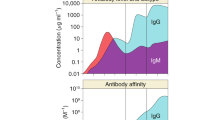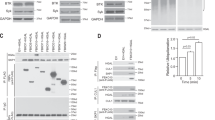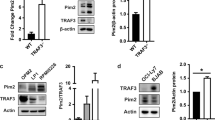Abstract
Phosphoinositide-3 kinase (PI3K) is thought to activate the tyrosine kinase Btk. However, through analysis of PI3K−/− and Btk−/− mice, B cell antigen receptor (BCR)-induced activation of Btk in mouse B cells was found to be unaffected by PI3K inhibitors or by a lack of PI3K. Consistent with this observation, PI3K−/− Btk−/− double-deficient mice had more severe defects than either single-mutant mouse. NF-κB activation along with Bcl-xL and cyclin D2 induction were severely blocked in both PI3K−/− and Btk−/− single-deficient B cells. Transgenic expression of Bcl-xL restored the development and BCR-induced proliferation of B cells in PI3K−/− mice. Our results indicate that PI3K and Btk have unique roles in proximal BCR signaling and that they have a common target further downstream in the activation of NF-κB.
This is a preview of subscription content, access via your institution
Access options
Subscribe to this journal
Receive 12 print issues and online access
$209.00 per year
only $17.42 per issue
Buy this article
- Purchase on Springer Link
- Instant access to full article PDF
Prices may be subject to local taxes which are calculated during checkout



Similar content being viewed by others
References
Fruman, D.A., Meyers, R.E. & Cantley, L.C. Phosphoinositide kinases. Annu. Rev. Biochem. 67, 481–507 (1998).
Katso, R. et al. Functions of phosphoinositide 3-kinases: implications for development, immunity, homeostasis, and cancer. Annu. Rev. Cell Dev. Biol. 17, 615–675 (2001).
Terauchi, Y. et al. Increased insulin sensitivity and hypoglycaemia in mice lacking the p85α subunit of phosphoinositide 3-kinase. Nat. Genet. 21, 230–235 (1999).
Suzuki, H. et al. Xid-like immunodeficiency in mice with disruption of the p85α subunit of phosphoinositide 3-kinase. Science 283, 390–392 (1999).
Fruman, D.A. et al. Impaired B cell development and proliferation in absence of phosphoinositide 3-kinase p85α. Science 283, 393–397 (1999).
Fruman, D.A., Cantley, L.C. & Carpenter, C.L. Structural organization and alternative splicing of the murine phosphoinositide 3-kinase p85α gene. Genomics 37, 113–121 (1996).
Inukai, K. et al. p85α gene generates three isoforms of regulatory subunit for phosphatidylinositol 3-kinase (PI 3-Kinase), p50α, p55α, and p85α, with different PI 3-kinase activity elevating responses to insulin. J. Biol. Chem. 272, 7873–7882 (1997).
Campbell, K.S. Signal transduction from the B cell antigen-receptor. Curr. Opin. Immunol. 11, 256–264 (1999).
Kurosaki, T. Genetic analysis of B cell antigen receptor signaling. Annu. Rev. Immunol. 17, 555–592 (1999).
Marshall, A.J., Niiro, H., Yun, T.J. & Clark, E.A. Regulation of B-cell activation and differentiation by the phosphatidylinositol 3-kinase and phospholipase Cγ pathway. Immunol. Rev. 176, 30–46 (2000).
Tedder, T.F., Sato, S., Poe, J.C. & Fujimoto, M. CD19 and CD22 regulate a B lymphocyte signal transduction pathway that contributes to autoimmunity. Keio J. Med. 49, 1–13 (2000).
Tsukada, S., Baba, Y. & Watanabe, D. Btk and BLNK in B cell development. Adv. Immunol. 77, 123–162 (2001).
Salim, K. et al. Distinct specificity in the recognition of phosphoinositides by the pleckstrin homology domains of dynamin and Bruton's tyrosine kinase. EMBO J. 15, 6241–6250 (1996).
Fukuda, M., Kojima, T., Kabayama, H. & Mikoshiba, K. Mutation of the pleckstrin homology domain of Bruton's tyrosine kinase in immunodeficiency impaired inositol 1,3,4,5-tetrakisphosphate binding capacity. J. Biol. Chem. 271, 30303–30306 (1996).
Satterthwaite, A.B., Li., Z. & Witte, O.N. Btk function in B cell development and response. Semin. Immunol. 10, 309–316 (1998).
Tarakhovsky, A. Xid and Xid-like immunodeficiencies from a signaling point of view. Curr. Opin. Immunol. 3, 319–323 (1997).
Fu, C., Turck, C.W., Kurosaki, T. & Chan, A.C. BLNK: a central linker protein in B cell activation. Immunity 9, 93–103 (1998).
Kurosaki, T. & Tsukada, S. BLNK: connecting Syk and Btk to calcium signals. Immunity 12, 1–5 (2000).
Varnai, P., Rother, K.I. & Balla, T. Phosphatidylinositol 3-kinase-dependent membrane association of the Bruton's tyrosine kinase pleckstrin homology domain visualized in single living cells. J. Biol. Chem. 274, 10983–10989 (1999).
Nore, B.F. et al. Redistribution of Bruton's tyrosine kinase by activation of phosphatidylinositol 3-kinase and Rho-family GTPases. Eur. J. Immunol. 30, 145–154 (2000).
Scharenberg, A.M. et al. Phosphatidylinositol-3,4,5-trisphosphate (PtdIns-3,4,5-P3)/Tec kinase-dependent calcium signaling pathway: a target for SHIP-mediated inhibitory signals. EMBO J. 17, 1961–1972 (1998).
Gold, M.R. et al. The B cell antigen receptor activates the Akt (protein kinase B)/glycogen synthase kinase-3 signaling pathway via phosphatidylinositol 3-kinase. J. Immunol. 163, 1894–1905 (1999).
Coffer, P.J., Jin, J. & Woodgett, J.R. Protein kinase B (c-Akt): a multifunctional mediator of phosphatidylinositol 3-kinase activation. Biochem. J. 335, 1–13 (1998).
Datta, S.R., Brunet, A. & Greenberg, M.E. Cellular survival: a play in three Akts. Genes. Dev. 13, 2905–2927 (1999).
Hemmings, B.A. Akt signaling: linking membrane events to life and death decisions. Science 275, 628–630 (1997).
Franke, T.F., Kaplan, D.R. & Cantley, L.C. PI3K: downstream AKTion blocks apoptosis. Cell 88, 435–437 (1997).
Burgering, B.M. & Coffer, P.J. Protein kinase B (c-Akt) in phosphatidylinositol-3-OH kinase signal transduction. Nature 376, 599–602 (1995).
Brozinick, J.T. Jr. & Birnbaum, M.J. Insulin, but not contraction, activates Akt/PKB in isolated rat skeletal muscle. J. Biol. Chem. 273, 14679–14682 (1998).
Forssell, J., Nilsson, A. & Sideras, P. Reduced formation of phosphatidic acid upon B-cell receptor triggering of mouse B-lymphocytes lacking Bruton's tyrosine kinase. Scand. J. Immunol. 52, 30–38 (2000).
Kane, L.P., Shapiro, V.S., Stokoe, D. & Weiss, A. Induction of NF-κB by the Akt/PKB kinase. Curr. Biol. 9, 601–604 (1999).
Bajpai, U.D., Zhang, K., Teutsch, M., Sen, R. & Wortis, H.H. Bruton's tyrosine kinase links the B cell receptor to nuclear factor κB activation. J. Exp. Med. 191, 1735–1744 (2000).
Petro, J.B., Rahman, S.M.J., Ballard, D.W. & Khan, W.N. Bruton's tyrosine kinase is required for activation of IκB kinase and nuclear factor κB in response to B cell receptor engagement. J. Exp. Med. 191, 1745–1754 (2000).
Miyamoto, S., Schmitt, M.J. & Verma, I.M. Qualitative changes in the subunit composition of κ B-binding complexes during murine B-cell differentiation. Proc. Natl. Acad. Sci. USA 91, 5056–5060 (1994).
Solvason, N. et al. Induction of cell cycle regulatory proteins in anti-immunoglobulin-stimulated mature B lymphocytes. J. Exp. Med. 184, 407–417 (1996).
Anderson, J.S., Teutsch, M., Dong, Z. & Wortis, H.H. An essential role for Bruton's tyrosine kinase in the regulation of B-cell apoptosis. Proc. Natl. Acad. Sci. USA 93, 10966–10971 (1996).
Solvason, N. et al. Transgene expression of bcl-xL permits anti-immunoglobulin (Ig)-induced proliferation in xid B cells. J. Exp. Med. 187, 1081–1091 (1998).
Buhl, A.M. & Cambier, J.C. Phosphorylation of CD19 Y484 and Y515, and linked activation of phosphatidylinositol 3-kinase, are required for B cell antigen receptor-mediated activation of Bruton's tyrosine kinase. J. Immunol. 162, 4438–4446 (1999).
Jou, S.T. et al. Essential, nonredundant role for the phosphoinositide 3-kinase p110δ in signaling by the B-cell receptor complex. Mol. Cell. Biol. 22, 8580–8591 (2002).
Takata, M. & Kurosaki, T. A role for Bruton's tyrosine kinase in B cell antigen receptor-mediated activation of phospholipase C-γ2. J. Exp. Med. 184, 31–40 (1996).
Engels, N., Wollscheid, B. & Wienands, J. Association of SLP-65/BLNK with the B cell antigen receptor through a non-ITAM tyrosine of Ig-α. Eur. J. Immunol. 31, 2126–2134 (2001).
Craxton, A., Jiang, A., Kurosaki, T. & Clark, E.A. Syk and Bruton's tyrosine kinase are required for B cell antigen receptor-mediated activation of the kinase Akt. J. Biol. Chem. 274, 30644–30650 (1999).
Romashkova, J.A. & Makarov, S.S. NF-κB is a target of AKT in anti-apoptotic PDGF signalling. Nature 401, 86–90 (1999).
Lee, H.H., Dadgostar, H., Cheng, Q., Shu, J. & Cheng, G. NF-κB-mediated up-regulation of Bcl-x and Bfl-1/A1 is required for CD40 survival signaling in B lymphocytes. Proc. Natl. Acad. Sci. USA 96, 9136–9141 (1999).
Jones, R.G. et al. Protein kinase B regulates T lymphocyte survival, nuclear factor κB activation, and Bcl-X(L) levels in vivo. J. Exp. Med. 191, 1721–1734 (2000).
Dillon, S.R., Mancini, M., Rosen, A. & Schlissel, M.S. Annexin V binds to viable B cells and colocalizes with a marker of lipid rafts upon B cell receptor activation. J. Immunol. 164, 1322–1332 (2000).
Fukao, T. et al. Selective loss of gastrointestinal mast cells and impaired immunity in PI3K-deficient mice. Nat. Immunol. 3, 295–304 (2002).
Fukao, T. et al. PI3K-mediated negative feedback regulation of IL-12 production in dendritic cells. Nat. Immunol. 3, 875–881 (2002).
Grillot, D.A.M. et al. Bcl-x exhibits regulated expression during B cell development and activation and modulates lymphocyte survival in transgenic mice. J. Exp. Med. 183, 381–391 (1996).
Baba, Y. et al. Involvement of Wiskott-Aldrich syndrome protein in B-cell cytoplasmic tyrosine kinase pathway. Blood 93, 2003–2012 (1999).
Acknowledgements
We thank N. Watanabe and M. Handa for help in some experiments; C. Maki for technical assistance; A. Sakurai, M. Motouchi and K. Furuichi for animal care; and Y. Fukui, T. Kurosaki and L.K. Clayton for suggestions and critical reading of the manuscript. This work was supported in part by a Grant-in-Aid for Creative Scientific Research (13GS0015), a Grant-in-Aid for Scientific Research (A) (13307012), (B) (14370116) and (C) (13670322), and a Grant-in-Aid for Scientific Research on Priority Areas (13037028) from the Japan Society for the Promotion of Science, a National Grant-in-Aid for the Establishment of a High-Tech Research Center in a private University, a grant for the Promotion of the Advancement of Education and Research in Graduate Schools, and a Scientific Frontier Research Grant from the Ministry of Education, Culture, Sports, Science and Technology, Japan.
Author information
Authors and Affiliations
Corresponding author
Ethics declarations
Competing interests
The authors declare no competing financial interests.
Rights and permissions
About this article
Cite this article
Suzuki, H., Matsuda, S., Terauchi, Y. et al. PI3K and Btk differentially regulate B cell antigen receptor-mediated signal transduction. Nat Immunol 4, 280–286 (2003). https://doi.org/10.1038/ni890
Received:
Accepted:
Published:
Issue Date:
DOI: https://doi.org/10.1038/ni890
This article is cited by
-
BTK inhibition limits B-cell–T-cell interaction through modulation of B-cell metabolism: implications for multiple sclerosis therapy
Acta Neuropathologica (2022)
-
Stimulus strength determines the BTK-dependence of the SHIP1-deficient phenotype in IgE/antigen-triggered mast cells
Scientific Reports (2018)
-
Mediation of transitional B cell maturation in the absence of functional Bruton’s tyrosine kinase
Scientific Reports (2017)
-
The c-Rel transcription factor and B-cell proliferation: a deal with the devil
Oncogene (2004)



